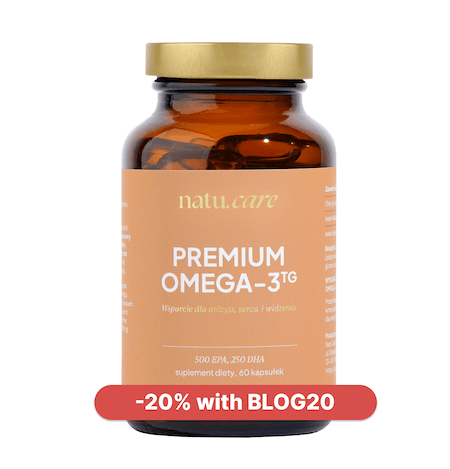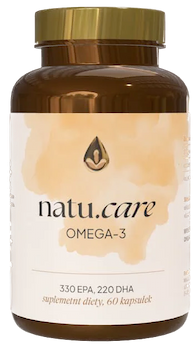- Home
- Omega acids
- Omega-9 acids
Omega-9 fatty acids: properties, sources, deficiency + nutritionist opinion
Omega-9 fatty acids are among the 'healthy fats' worth consuming in a varied diet.


Learn more about our editorial process
.

Learn more about our editorial process
.

Learn more about our editorial process
.

Learn more about our editorial process
.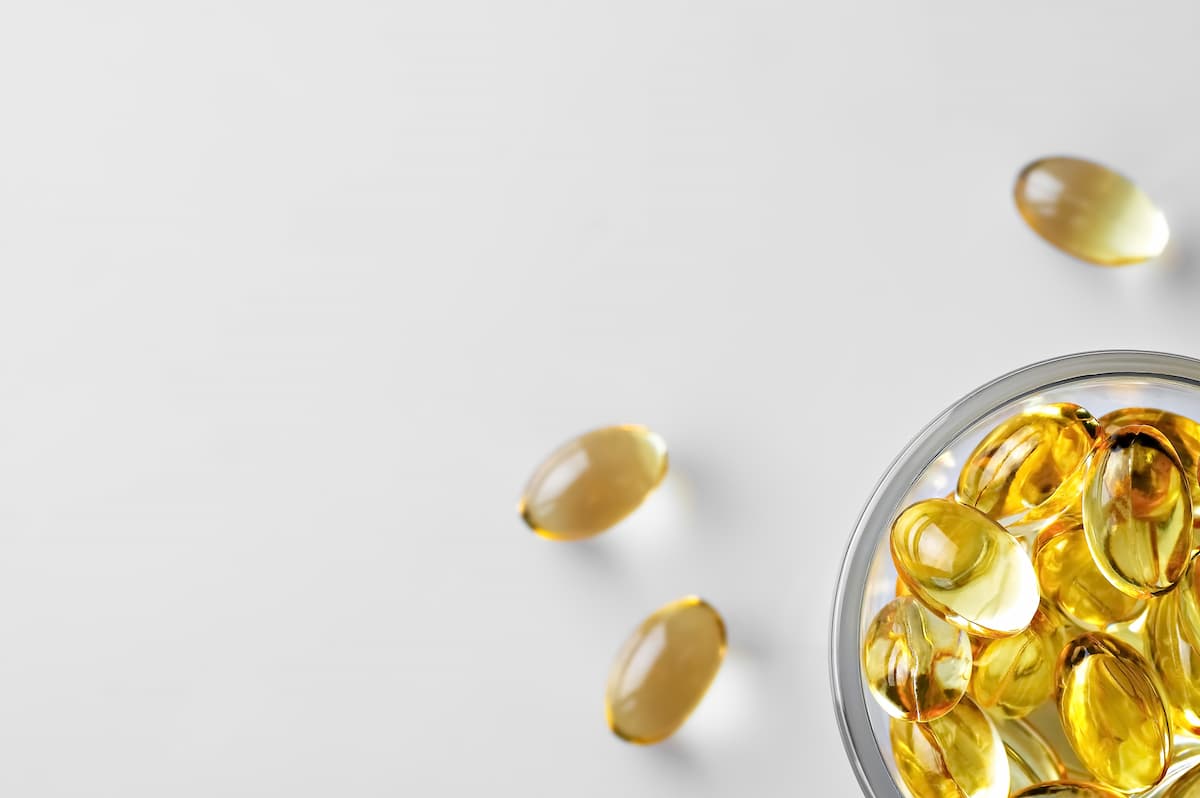
Why you can trust us
Articles on Natu.Care are written based on scientific research, data from government websites and other reliable sources. The texts are written in cooperation with doctors, nutritionists and other health and beauty experts. Articles are reviewed before publication and during significant updates.
.Learn more about our editorial process
.Information about advertisements
Content on Natu.Care may contain links to products from the sale of which we may receive a commission. When creating content, we adhere to high editorial standards and take care to be objective about the products discussed. The presence of affiliate links is not dictated by our partners, and we select the products we review ourselves completely independently.
.Learn more about our terms and Conditions
.You know that healthy fats are - zero surprises - healthy. Omega acids are mainly associated with omega-3, but after all, there's also omega-9 - a little overlooked, but perhaps just as important?
.
The dietetics world has been living a drama for some years now relating to the ratio of omega-3 and omega-6 fatty acids. Omega-3s are settling on fatty laurels, omega-6s are trying to warm up their image. And the omega-9s... lie back and sip drinks of vegetable oil.
Omega-9 acids don't look for conflict, they do their job (for the body, mind and even... industry) and yet they produce themselves in the body, so you don't have to worry about them.
In this article, omega-9 acids get their five minutes. You'll get to know them up close and find out whether you need to throw your favourite mustard in the bin (well, and whether rapeseed oil for hair is a weird trend from TikTok or effective hair care).
From this article you will learn:
- What are omega-9 acids.
- What are omega-9 acids?
- What types of omega-9 acids there are. .
- What good these acids do for the body. .
- Where are omega-9 acids in food .
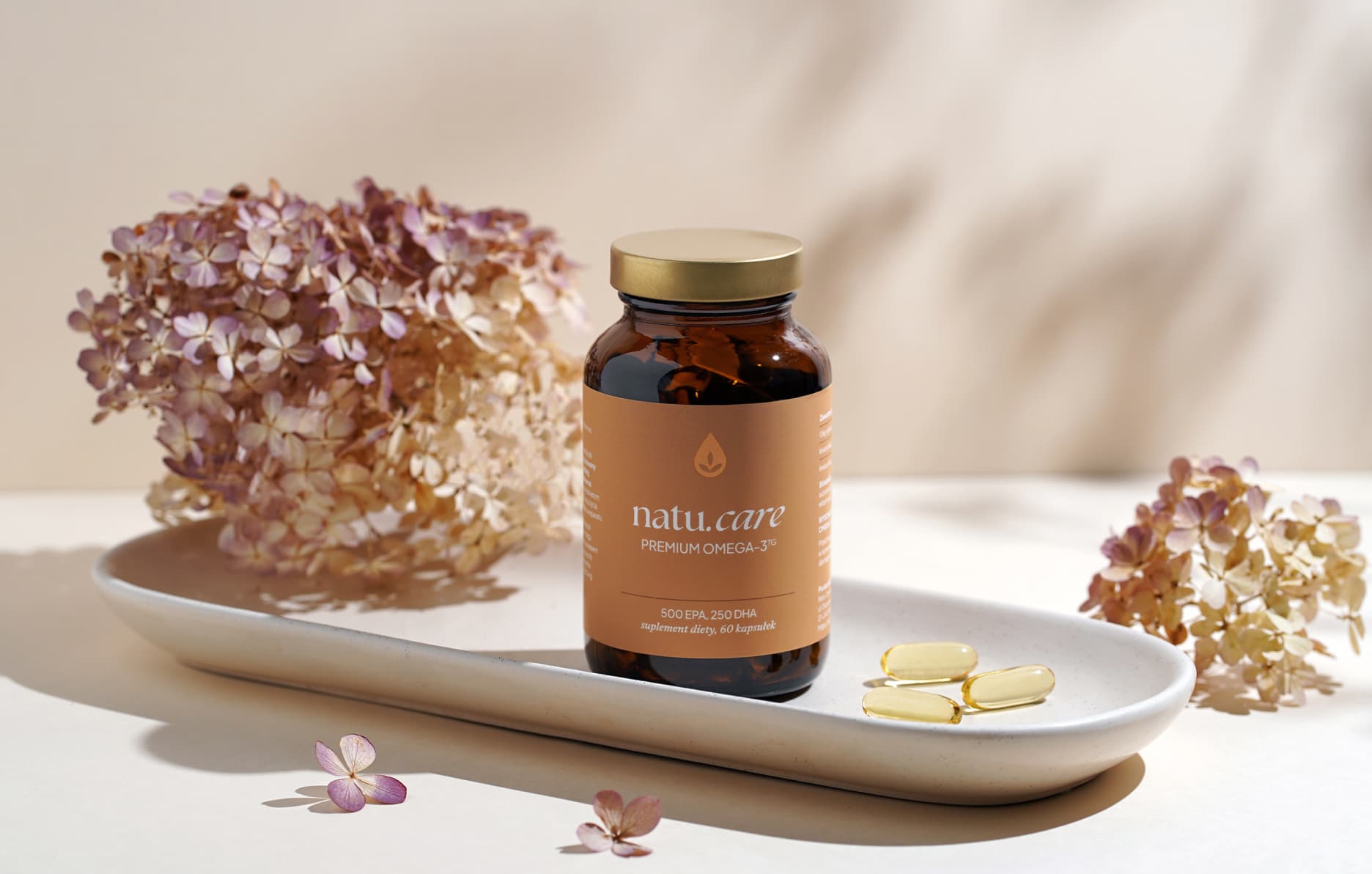
Sprawdź, za co pokochały go tysiące klientek Natu.Care Premium Omega-3ᵀᴳ -15% z kodem BLOG15
Natu.Care Omega-3ᵀᴳ Premium
Natu.Care Omega-3ᵀᴳ Premium dla zdrowia serca, mózgu i odporności. Najlepsza przyswajalność. Optymalna dawka 750 mg. Przebadana przez niezależne laboratorium.
Zobacz więcej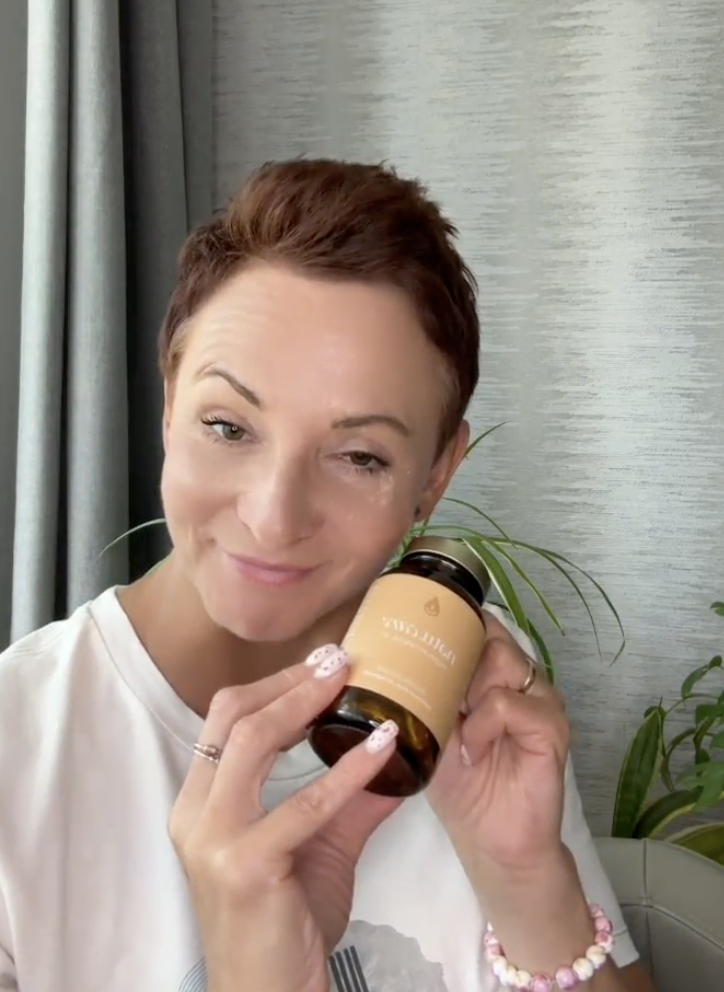
Produkt ma super skład, transparentną etykietę i co dla mnie jest ważne – małe kapsułki do połknięcia. Nie ma też nieprzyjemnego efektu odbijania rybą, który miałam spożywając inne produkty. Widzę znaczną poprawę odporności. Polecam!@Kasia P.
See also:
.- Omega acids .
- Omega-3 fatty acids
- Omega-3 fatty acid deficiency
- Omega-6 fatty acids
- Omega-3 in tablets
- Omega-3-6-9 .
- DHA acid .
- EPA acid .
- ALA acid .
Omega acids - essential fats
.The omega group of fatty acids is essential for energy production, building cell membranes, production of hormones and neurotransmitters. They influence the proper functioning of the nervous, endocrine, cardiovascular and immune systemsand. The best researched and known omega acids are 3, 6 and 9.
Omega-9 fatty acids are monounsaturated fatty acids (MUFAs). Your body produces them on its own, but this amount does not fully compensate for all its needs, so it is worth sourcing them from diet.
The omega-9 fatty acids are conditionally included in the group of essential fatty acids because the body is able to produce it on its own if it has sufficient omega-3 and omega-6 fatty acids. However, it is worth including them in the diet..
 .
.
Alexandra Cudna Clinical nutritionist
Which omega acid is most important?
.Without beating around the bush - omega-3 fatty acids. They're all important, but omega-3 fatty acids aren't enough that you won't make on your own, and you're probably only taking them in residual amounts.
Omega-6 fatty acids are ubiquitous in our diet. What's more, you're probably providing them in a ratio of 17 to 1 relative to omega-3and. A healthy ratio is between 1:1 and 4:1.
Similarly with omega-9 - these acids are ubiquitous in our diet, and your body can also make them from other omega acids if needed. If you want to take care of your health by enriching your diet with omega acids, focus on omega-3 acids.
Product description
The dietary supplement contains omega-3ᵀᴳ, or omega-3 acids in the form of trójglyceridesów. Scientific studies suggest that this form of fatty acidsós up to 2 times better absorbed than the estersós present in many dietary supplements on the market. This means that you are assured of their effectiveness and of supplying yourself with valuable omega acids.
Fatty acids omega-3 are derived from wild anchovy oil. It is a rich source of healthy fats that are essential for the health of the cardiovascular, immune and nervous systems, as well as the proper function of vision, joints muscles.
Scientific research suggests that wild anchovies are a good source of healthy fats.
Scientific research also suggests that an adequate intake of omega-3 fatty acidsós protects against and supports the treatment of depression and anxiety disorders. In addition, omega-3s influence the hydration and appearance of the skinóry and support healthy sleep.
.
The formula contains a total of 750 mg of EPA+DHA acidsós, which is three times higher than the recommended minimum of 250 mg for the Polish population. Omega-3 TG Premium has studies indicating that its TOTOX is 9, which is a very good result.
Supplementation of omega-3 fatty acidsóis recommended for anyone who does not eat 1–2 portions (approximately 300 g) of oily fish per week. Children during growth, seniors, physically active people, vegans and vegetarians, as well as patients undergoing cardiovascular treatment and prevention of heart disease also have an increased need.
Pros and cons
The dietary supplement contains omega-3ᵀᴳ, or omega-3 acids in the form of trójglyceridesów. Scientific studies suggest that this form of fatty acidsós up to 2 times better absorbed than the estersós present in many dietary supplements on the market. This means that you are assured of their effectiveness and of supplying yourself with valuable omega acids.
Fatty acids omega-3 are derived from wild anchovy oil. It is a rich source of healthy fats that are essential for the health of the cardiovascular, immune and nervous systems, as well as the proper function of vision, joints muscles.
Scientific research suggests that wild anchovies are a good source of healthy fats.
Scientific research also suggests that an adequate intake of omega-3 fatty acidsós protects against and supports the treatment of depression and anxiety disorders. In addition, omega-3s influence the hydration and appearance of the skinóry and support healthy sleep.
.
The formula contains a total of 750 mg of EPA+DHA acidsós, which is three times higher than the recommended minimum of 250 mg for the Polish population. Omega-3 TG Premium has studies indicating that its TOTOX is 9, which is a very good result.
Supplementation of omega-3 fatty acidsóis recommended for anyone who does not eat 1–2 portions (approximately 300 g) of oily fish per week. Children during growth, seniors, physically active people, vegans and vegetarians, as well as patients undergoing cardiovascular treatment and prevention of heart disease also have an increased need.
Additional information
The dietary supplement contains omega-3ᵀᴳ, or omega-3 acids in the form of trójglyceridesów. Scientific studies suggest that this form of fatty acidsós up to 2 times better absorbed than the estersós present in many dietary supplements on the market. This means that you are assured of their effectiveness and of supplying yourself with valuable omega acids.
Fatty acids omega-3 are derived from wild anchovy oil. It is a rich source of healthy fats that are essential for the health of the cardiovascular, immune and nervous systems, as well as the proper function of vision, joints muscles.
Scientific research suggests that wild anchovies are a good source of healthy fats.
Scientific research also suggests that an adequate intake of omega-3 fatty acidsós protects against and supports the treatment of depression and anxiety disorders. In addition, omega-3s influence the hydration and appearance of the skinóry and support healthy sleep.
.
The formula contains a total of 750 mg of EPA+DHA acidsós, which is three times higher than the recommended minimum of 250 mg for the Polish population. Omega-3 TG Premium has studies indicating that its TOTOX is 9, which is a very good result.
Supplementation of omega-3 fatty acidsóis recommended for anyone who does not eat 1–2 portions (approximately 300 g) of oily fish per week. Children during growth, seniors, physically active people, vegans and vegetarians, as well as patients undergoing cardiovascular treatment and prevention of heart disease also have an increased need.
Expert opinion
The dietary supplement contains omega-3ᵀᴳ, or omega-3 acids in the form of trójglyceridesów. Scientific studies suggest that this form of fatty acidsós up to 2 times better absorbed than the estersós present in many dietary supplements on the market. This means that you are assured of their effectiveness and of supplying yourself with valuable omega acids.
Fatty acids omega-3 are derived from wild anchovy oil. It is a rich source of healthy fats that are essential for the health of the cardiovascular, immune and nervous systems, as well as the proper function of vision, joints muscles.
Scientific research suggests that wild anchovies are a good source of healthy fats.
Scientific research also suggests that an adequate intake of omega-3 fatty acidsós protects against and supports the treatment of depression and anxiety disorders. In addition, omega-3s influence the hydration and appearance of the skinóry and support healthy sleep.
.
The formula contains a total of 750 mg of EPA+DHA acidsós, which is three times higher than the recommended minimum of 250 mg for the Polish population. Omega-3 TG Premium has studies indicating that its TOTOX is 9, which is a very good result.
Supplementation of omega-3 fatty acidsóis recommended for anyone who does not eat 1–2 portions (approximately 300 g) of oily fish per week. Children during growth, seniors, physically active people, vegans and vegetarians, as well as patients undergoing cardiovascular treatment and prevention of heart disease also have an increased need.
Product description
The dietary supplement contains high-quality fatty acids omega-3 from anchovy oil. It is a naturally rich source of healthy fats that are essential for cardiovascular, immune and nervous system health, as well as proper function of eyesight, joints muscles.
Scientific research also suggests that an adequate intake of omega-3 fatty acidsós protects against and supports the treatment of depression and anxiety disorders. In addition, omega-3s influence the hydration and appearance of the skinóry and support healthy sleep.
.
The dietary supplement contains 550 mg EPA+DHA per daily serving. This is more than double the official recommendations for the Polish population, whichóre suggesting an intake of at least 250 mg per day.
Supplementation of EPA+DHA is a good way to support healthy sleep.
Supplementation with omega-3 fatty acidsós is advisable if you do not consume 1–2 portions (approx. 300 g) of oily fish per week. There is also an increased need for physically active people, vegans and vegetarians, seniors, children during growth spurts and patients undergoing cardiovascular treatment and prevention of heart disease.
Pros and cons
The dietary supplement contains high-quality fatty acids omega-3 from anchovy oil. It is a naturally rich source of healthy fats that are essential for cardiovascular, immune and nervous system health, as well as proper function of eyesight, joints muscles.
Scientific research also suggests that an adequate intake of omega-3 fatty acidsós protects against and supports the treatment of depression and anxiety disorders. In addition, omega-3s influence the hydration and appearance of the skinóry and support healthy sleep.
.
The dietary supplement contains 550 mg EPA+DHA per daily serving. This is more than double the official recommendations for the Polish population, whichóre suggesting an intake of at least 250 mg per day.
Supplementation of EPA+DHA is a good way to support healthy sleep.
Supplementation with omega-3 fatty acidsós is advisable if you do not consume 1–2 portions (approx. 300 g) of oily fish per week. There is also an increased need for physically active people, vegans and vegetarians, seniors, children during growth spurts and patients undergoing cardiovascular treatment and prevention of heart disease.
Additional information
The dietary supplement contains high-quality fatty acids omega-3 from anchovy oil. It is a naturally rich source of healthy fats that are essential for cardiovascular, immune and nervous system health, as well as proper function of eyesight, joints muscles.
Scientific research also suggests that an adequate intake of omega-3 fatty acidsós protects against and supports the treatment of depression and anxiety disorders. In addition, omega-3s influence the hydration and appearance of the skinóry and support healthy sleep.
.
The dietary supplement contains 550 mg EPA+DHA per daily serving. This is more than double the official recommendations for the Polish population, whichóre suggesting an intake of at least 250 mg per day.
Supplementation of EPA+DHA is a good way to support healthy sleep.
Supplementation with omega-3 fatty acidsós is advisable if you do not consume 1–2 portions (approx. 300 g) of oily fish per week. There is also an increased need for physically active people, vegans and vegetarians, seniors, children during growth spurts and patients undergoing cardiovascular treatment and prevention of heart disease.
Expert opinion
The dietary supplement contains high-quality fatty acids omega-3 from anchovy oil. It is a naturally rich source of healthy fats that are essential for cardiovascular, immune and nervous system health, as well as proper function of eyesight, joints muscles.
Scientific research also suggests that an adequate intake of omega-3 fatty acidsós protects against and supports the treatment of depression and anxiety disorders. In addition, omega-3s influence the hydration and appearance of the skinóry and support healthy sleep.
.
The dietary supplement contains 550 mg EPA+DHA per daily serving. This is more than double the official recommendations for the Polish population, whichóre suggesting an intake of at least 250 mg per day.
Supplementation of EPA+DHA is a good way to support healthy sleep.
Supplementation with omega-3 fatty acidsós is advisable if you do not consume 1–2 portions (approx. 300 g) of oily fish per week. There is also an increased need for physically active people, vegans and vegetarians, seniors, children during growth spurts and patients undergoing cardiovascular treatment and prevention of heart disease.
ALLNUTRITION Omega 3 Strong
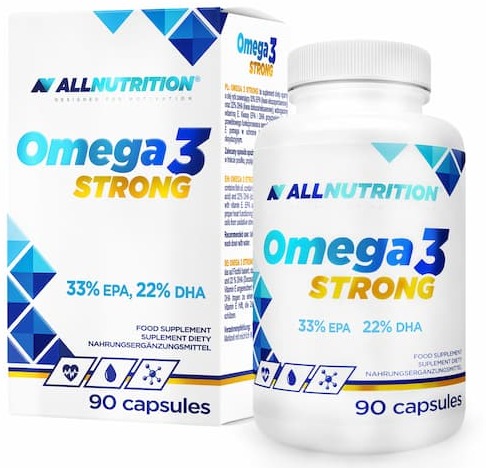
- Content omega-3 acids: 550 mg (DHA 220 mg + EPA 330 mg)
- Additional active ingredients: vitamin E
- Form: capsules .
- Dose: 1 capsule per day .
- Sufficient for: 90 days .
Product description
A dietary supplement with a solid portion of DHA and EPA – valuable for health and well-being omega-3 acidsós. Indicated especially for people on a plant-based diet, physically active people and seniors.
.The sourceóof omega-3 acids in this preparation is fish oil.
.Pros and cons
A dietary supplement with a solid portion of DHA and EPA – valuable for health and well-being omega-3 acidsós. Indicated especially for people on a plant-based diet, physically active people and seniors.
.The sourceóof omega-3 acids in this preparation is fish oil.
.Additional information
A dietary supplement with a solid portion of DHA and EPA – valuable for health and well-being omega-3 acidsós. Indicated especially for people on a plant-based diet, physically active people and seniors.
.The sourceóof omega-3 acids in this preparation is fish oil.
.User review
A dietary supplement with a solid portion of DHA and EPA – valuable for health and well-being omega-3 acidsós. Indicated especially for people on a plant-based diet, physically active people and seniors.
.The sourceóof omega-3 acids in this preparation is fish oil.
.Solgar Omega 3-6-9
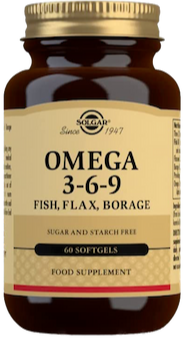
- Content of omega acids:.
- Omega-3 fatty acids.
- Omega-3 fatty acids
- alpha-linolenic acid (ALA) – 585 mg
.- eicosapentaenoic acid (EPA) – 344 mg
- docosahexaenoic acid (DHA) – 221 mg
.
- Omega-3 fatty acids
- Omega-6 fatty acids.
- linoleic acid (LA) – 598 mg .
- gamma-linolenic acid (GLA) – 274 mg .
- Omega-9 fatty acids.
- Oleic acid – 325 mg .
- Omega-3 fatty acids.
- Source of omega acids: fish oil from anchovies, mackerel, sardines, linseed oil, cucumber oil .
- Form: capsules .
- Packaging: 60 capsules .
- Daily allowance:3 capsules per day .
- Sufficient for: 20 days .
Product description
A combination of omega 3-6-9 fatty acidsós derived from fish and plants. The dietary supplement supplements essential omega fatty acids, whichóre needed for the proper functioning of many systemsóorgansóin the body.
Pros and cons
A combination of omega 3-6-9 fatty acidsós derived from fish and plants. The dietary supplement supplements essential omega fatty acids, whichóre needed for the proper functioning of many systemsóorgansóin the body.
Additional information
A combination of omega 3-6-9 fatty acidsós derived from fish and plants. The dietary supplement supplements essential omega fatty acids, whichóre needed for the proper functioning of many systemsóorgansóin the body.
A combination of omega 3-6-9 fatty acidsós derived from fish and plants. The dietary supplement supplements essential omega fatty acids, whichóre needed for the proper functioning of many systemsóorgansóin the body.
Omega + Vitamin D3 800 IU for children
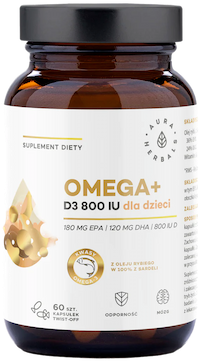
- Content of omega-3 fatty acids: 300 mg (180 mg EPA + 120 mg DHA)
- .
- Additional active ingredients: vitamin D3
- Form: twist-off capsules
- .
- Dose: 1 capsule per day
- .
- Sufficient for: 60 days
- .
Product description
Omega-3 acids for children with added vitamin D3 in good doses. The formula fills the daily requirement of EPA and DHA and vitamin D for children aged 2–18 years.
The Ministry of Health recommends supplementation with vitamin D3. In turn, omega-3 fatty acids are also crucial for the youngest.
The dietary supplement from Aura Herbals supports mós brain function, proper vision and immune system function.
The omega-3 fatty acids are derived from fish oil sourced from anchovies.
Pros and cons
Omega-3 acids for children with added vitamin D3 in good doses. The formula fills the daily requirement of EPA and DHA and vitamin D for children aged 2–18 years.
The Ministry of Health recommends supplementation with vitamin D3. In turn, omega-3 fatty acids are also crucial for the youngest.
The dietary supplement from Aura Herbals supports mós brain function, proper vision and immune system function.
The omega-3 fatty acids are derived from fish oil sourced from anchovies.
Additional information
Omega-3 acids for children with added vitamin D3 in good doses. The formula fills the daily requirement of EPA and DHA and vitamin D for children aged 2–18 years.
The Ministry of Health recommends supplementation with vitamin D3. In turn, omega-3 fatty acids are also crucial for the youngest.
The dietary supplement from Aura Herbals supports mós brain function, proper vision and immune system function.
The omega-3 fatty acids are derived from fish oil sourced from anchovies.
User review
Omega-3 acids for children with added vitamin D3 in good doses. The formula fills the daily requirement of EPA and DHA and vitamin D for children aged 2–18 years.
The Ministry of Health recommends supplementation with vitamin D3. In turn, omega-3 fatty acids are also crucial for the youngest.
The dietary supplement from Aura Herbals supports mós brain function, proper vision and immune system function.
The omega-3 fatty acids are derived from fish oil sourced from anchovies.
{ product:1ZN0pnin20IQ025sIqOBUF }}
Properties of omega-9 acids
.Recent research has demonstrated several health-promoting properties of omega-9 fatty acids.
.Promote the cardiovascular system
.Omega-9 acids reduce inflammation, lower blood pressure and improve lipid profileand. They have a protective effect on the heart, cardiovascular system and reduce the risk of atherosclerosisand.
According to the National Institute of Public Health, Poles are most commonly affected by cardiovascular disease - coronary heart disease, atherosclerosis, hypertension and stroke .
.Anti-inflammatory effects
.Thanks to their anti-inflammatory properties, they may help reduce the risk of chronic disease, cancer and cardiovascular disease .
Promote skin health
.Improve skin health by reducing inflammation and improving barrier functionand. Omega-9 acids reduce water loss from the skin and slow down the ageing process thanks to their antioxidant effects.
I used rapeseed oil on my hair. Am I crazy?
.No, try oiling hair with this oil. It is a natural humectant, meaning it retains moisture in the hair and prevents it from drying out. The hair doesn't frizz and it creates a nice taffy when it dries. Just put a tablespoon of oil smeared in your hands on dry hair from the ear down for 30 minutes and wash your scalp and hair twice.
Help maintain body weight
.Omega-9 fatty acids can help control body weight by reducing appetite and providing a feeling of satietyand. Research shows that meals rich in healthy fats keep you satiated for longer, which reduces the desire to snack and prevents overweight .
Fats are needed in the diet. They should not be avoided. Meals low in fat (e.g. the popular light or 0%) do not satiate as effectively as those with healthy fats. It's worth adding vegetable oils to salads or peanut butter to oatmeal for breakfast..
 .
.
Alexandra Cudna Clinical nutritionist
Types of omega-9 fatty acids
.The most important and best-studied representatives of this group are the acidsand:
- oleic, .
- nervous, .
- erucic, .
Oleic acid
.Oleic acid is the most common and best studied omega-9 fatty acidand. You can find this acid in olive oil and grapeseed, sea buckthorn and almond oils, as well as nuts and avocados .
What are the benefits of consuming oleic acid?
.- .
- Reduces the risk of coronary heart disease. Studies have shown that a diet high in oleic acid can reduce 'bad' LDL cholesterol, protecting against coronary heart disease.
The Mediterranean diet, in which olive oil (a source of oleic acid) has a special place, has been named the healthiest diet in the world.
 .
.
Alexandra Cudna Clinical nutritionist
What else are the characteristics of oleic acid?
.- Vegetable oils high in oleic acid have better stability compared to other vegetable oils, which can help preserve their health benefits during heat processingand. .
- This is a colourless and odourless acid used in various cosmetic products to enhance product absorption and moisture retention. When applied to the skin, it combats signs of ageing and dry skinand. .
- Oleic acid has applications in cosmetology, e.g. it gives softness and elasticity to sticks, prevents them from crumbling and makes them easier to spread, e.g. on the lips. .
- When applied to hair, cosmetics with this acid prevent excessive evaporation of water from the hair surface, softening and smoothing it. .
Nerveic acid
.This acid is important for the functioning of the brain and peripheral nervous tissueand. It is an important component of the brain's white matter - the part of the central nervous system (CNS) that includes the brain and spinal cord .
It is the main component of cerebrosides, the cells responsible for building the myelin sheath of nerve fibres . It plays a key role in the rapid and efficient conduction of nerve signals in the nervous system.
Erucic acid
.We've patted omega-9 acids on the back, but it's time to meet the black sheep in the fat family.
Animal studies have shown the toxic nature of erucic acid. It causes steatosis of parenchymal organs and damage to the heart muscle.
Erucic acid has been shown to be a toxic substance.
Sources of erucic acid include rapeseed and mustardand.
.Now, right away, does that mean you have to throw rapeseed oil in the rubbish?
.No - the nutritionist explains:
.Commercially available rapeseed oil is obtained from a refined variety of rapeseed. The erucic acid content of such oil is very low and is not harmful to humans..
 .
.
Alexandra Cudna Clinical nutritionist
What about your favourite mustard? Rest assured. Nowadays, mustards are also made using methods that reduce erucic acid, so eat them with taste (and peace of mind).
Erucic acid also has several industrial uses, including as a lubricant, surfactant, biodiesel ingredient and composite materials.
Omega-9 fatty acid deficiency - symptoms
.A diet deficient in oleic acid, the most important omega-9 acid, can lead toand:
- .
- deterioration of the skin (dryness, irritation, acne), .
- disorders of the nervous system, .
- disorders of lipid metabolism and insulin resistance, .
- deterioration of blood lipid profile, .
- deterioration of the intestinal barrier function, .
- increased risk of heart disease, .
Can omega-9 fatty acids be overdosed?
Overdose of omega-9 fatty acids is most commonly associated with over-supplementation of combined "Omega 3-6-9" type preparations.
Symptoms of excess omega-9 acids includeand:
- weight gain, .
- development of metabolic diseases, e.g. type II diabetes, insulin resistance. .
Excessive intake of omega-9 fatty acids increases the risk of heart disease and cancer..
 .
.
Alexandra Cudna Clinical nutritionist
It is very difficult to get an excess of omega-9 fatty acids from your diet, so first and foremost, pay attention to the supplements with omega acids that you are taking.
The most important thing to take in supplementation is omega-3 acids, which we are most at risk of deficiency.
Do not buy "3-6-9" supplements. These products are perhaps the best illustration of the saying What's too much is unhealthy.
Learn more:
.Sources of omega-9 fatty acids
.Where can you find the most omega-9 fatty acids? Look for them in plant oils and those made from seedsand. Take care with seeds and nuts too.
.|
Product . |
Content of omega-9 acids in 100 g* |
|
| . |
Rape seed oil |
9220 mg |
|
Olive oil |
7120 mg |
|
|
Avocado oil |
6700 mg |
|
|
Sesame seeds |
6700 mg |
|
|
Pumpkin seeds |
5739 mg |
|
|
Corn oil |
4860 mg |
|
|
Sesame oil |
3900 mg |
|
|
Fat from goose |
3685 mg |
|
|
100% peanut butter |
3440 mg |
|
|
Cashew nuts |
2520 mg |
*The content of omega-9 fatty acids in foods can vary depending on a number of factors, such as heat treatment or farming method.
See also:
- Guide: which omega-3 acids to choose?
- Omega-3 in an athlete's diet
- The powerful EPA + DHA duo, how does it work?
- Best sources of omega-3 in the diet
- Triglycerides - why are they better than ethyl esters?
- Omega drug, not a supplement. Doctor's opinion
- Omega-3 in tablets - ranking
- Best healthy breakfast recipes
Omega-9 fatty acids have their own important role in the body. Most importantly, you don't need to supplement them, and your favourite mustard won't hurt you, but will please your palate.
Summary
.- Omega-9 fatty acids are monounsaturated fatty acids that the body produces on its own.
- You do not need to provide them with your diet, although it is recommended to obtain them from healthy fats rather than dietary supplements.
- The best studied and known omega-9 acids are oleic, nervonic and erucic acids. .
- The omega-9 fatty acids support the cardiovascular and nervous systems, support mental health, reduce inflammation in the body and affect skin health.
- The omega-9 fatty acids are also known to support the cardiovascular and nervous systems, support mental health, reduce inflammation in the body and affect skin health.
- Deficiency and excess of omega-9 fatty acids have no clear symptoms, but abnormal amounts can cause dry skin and eyes, blood clotting disorders, and immune system problems.
- The best sources of omega-9 fatty acids are vegetable oils, and canola oil contains the most. .
FAQ
.What are omega-9 acids in?
.Most omega-9 acids are found in vegetable oils, nuts (mainly walnuts, cashews) and seeds. The richest sources of omega-9 fatty acids are rapeseed oil, olive oil and avocado oil. It is worth consuming these products in the diet.
How much omega-9 fatty acids per day?
.There are no official standards for the daily intake of omega-9 fatty acids. However, it is worth consuming them in moderation along with other healthy fats omega-3 and omega-6. Pay particular attention to the consumption of omega-3 fatty acids, as their deficiency occurs most frequently.
What does omega-9 acid help with?
.Omega-9 acids support the proper functioning of the cardiovascular system, nervous system, sugar and insulin metabolism and control inflammation in the body. Their correct amount affects the psyche and mood as well as skin condition.
What are the healthiest omega acids?
.All the acids in the omega family are important, but omega-3 acids, particularly EPA (eicosapentaenoic) and DHA (docosahexaenoic), are the most beneficial for health and well-being. They affect the nervous system and brain, reduce blood pressure, reduce the risk of cardiovascular disease, neurodegenerative diseases, autoimmune diseases and inflammation.
What omega acids for lowering cholesterol?
.Omeega-3 fatty acids, especially EPA and DHA, are the most effective at lowering cholesterol. By including oily fish or supplementation with omega-3 fatty acids in the diet, we can reduce LDL 'bad' cholesterol.
What kind of omega acids for the heart?
The best omega acids to support the heart and overall cardiovascular system are omega-3 acids, especially EPA (eicosapentaenoic) and DHA (docosahexaenoic). They show anti-inflammatory properties, lower blood pressure and reduce the risk of blood clots.
What to fry when you have high cholesterol?
.When you have high cholesterol, it is worth frying with oils rich in healthy fats, such as rapeseed oil and olive oil, which support cardiovascular health. However, it is worth switching to steaming or roasting.
Sources
.See all
.Basu, A., Devaraj, S., & Jialal, I. (2006). Dietary factors that promote or retard inflammation. Arteriosclerosis, Thrombosis, and Vascular Biology, 26(5), 995-1001. https://doi.org/10.1161/01.ATV.0000214295.86079.d1
Farag, M. A., & Gad, M. Z. (2022). Omega-9 fatty acids: Potential roles in inflammation and cancer management. Journal of Genetic Engineering and Biotechnology, 20(1), 48. https://doi.org/10.1186/s43141-022-00329-0
Gajdoš, P., Hambalko, J., Slaný, O., & Čertík, M. (2020). Conversion of waste materials into very long chain fatty acids by the recombinant yeast Yarrowia lipolytica. FEMS Microbiology Letters, 367(6), fnaa042. https://doi.org/10.1093/femsle/fnaa042
Johnson, M. (2014). Omega-3, Omega-6 and Omega-9 Fatty Acids: Implications for Cardiovascular and Other Diseases. Journal of Glycomics & Lipidomics, 04(04). https://doi.org/10.4172/2153-0637.1000123
Medeiros-de-Moraes, I. M., Gonçalves-de-Albuquerque, C. F., Kurz, A. R. M., Oliveira, F. M. de J., Abreu, V. H. P. de, Torres, R. C., Carvalho, V. F., Estato, V., Bozza, P. T., Sperandio, M., Castro-Faria-Neto, H. C. de, & Silva, A. R. (2018). Omega-9 Oleic Acid, the Main Compound of Olive Oil, Mitigates Inflammation during Experimental Sepsis. Oxidative Medicine and Cellular Longevity, 2018, e6053492. https://doi.org/10.1155/2018/6053492
Menendez, J. A., & Lupu, R. (2006). Mediterranean dietary traditions for the molecular treatment of human cancer: Anti-oncogenic actions of the main olive oil's monounsaturated fatty acid oleic acid (18:1n-9). Current Pharmaceutical Biotechnology, 7(6), 495-502. https://doi.org/10.2174/138920106779116900
Monounsaturated Fatty Acid-Enriched High-Fat Diets Impede Adipose NLRP3 Inflammasome-Mediated IL-1β Secretion and Insulin Resistance Despite Obesity | Diabetes | American Diabetes Association. (n.d.). Retrieved 19 April 2023, from https://diabetesjournals.org/diabetes/article/64/6/2116/34911/Monounsaturated-Fatty-Acid-Enriched-High-Fat-Diets
Omega-9 Fatty Acid-An overview | ScienceDirect Topics. (n.d.). Retrieved 23 March 2023, from https://www.sciencedirect.com/topics/agricultural-and-biological-sciences/omega-9-fatty-acid
Piccinin, E., Cariello, M., De Santis, S., Ducheix, S., Sabbà, C., Ntambi, J. M., & Moschetta, A. (2019). Role of Oleic Acid in the Gut-Liver Axis: From Diet to the Regulation of Its Synthesis via Stearoyl-CoA Desaturase 1 (SCD1). Nutrients, 11(10), Article 10. https://doi.org/10.3390/nu11102283
Rahman, S. M., Takagi, Y., Kubota, K., Miyamoto, K., & Kawakita, T. (1994). High Oleic Acid Mutant in Soybean Induced by X-Ray Irradiation. Bioscience, Biotechnology, and Biochemistry, 58(6), 1070-1072. https://doi.org/10.1271/bbb.58.1070
Rees, K., Hartley, L., Flowers, N., Clarke, A., Hooper, L., Thorogood, M., & Stranges, S. (2013). "Mediterranean" dietary pattern for the primary prevention of cardiovascular disease. The Cochrane Database of Systematic Reviews, 8, CD009825. https://doi.org/10.1002/14651858.CD009825.pub2
Ryan, M., McInerney, D., Owens, D., Collins, P., Johnson, A., & Tomkin, G. H. (2000). Diabetes and the Mediterranean diet: A beneficial effect of oleic acid on insulin sensitivity, adipocyte glucose transport and endothelium-dependent vasoreactivity. QJM: An International Journal of Medicine, 93(2), 85-91. https://doi.org/10.1093/qjmed/93.2.85
Sales-Campos, H., Souza, P., Peghini, B., Silva, J., & Cardoso, C. (2012). An Overview of the Modulatory Effects of Oleic Acid in Health and Disease. Mini reviews in medicinal chemistry, 13. https://doi.org/10.2174/1389557511313020003
Shahidi, F., & Ambigaipalan, P. (2018). Omega-3 Polyunsaturated Fatty Acids and Their Health Benefits. Annual Review of Food Science and Technology, 9(1), 345-381. https://doi.org/10.1146/annurev-food-111317-095850
The health situation of the Polish population and its determinants-Report for 2020. (2021, February 2). NIZP PZH - PIB. https://www.pzh.gov.pl/sytuacja-zdrowotna-ludnosci-polski-i-jej-uwarunkowania-raport-za-2020-rok/
Thomas, A. (2000). Fats and Fatty Oils. In Ullmann's Encyclopedia of Industrial Chemistry. John Wiley & Sons, Ltd. https://doi.org/10.1002/14356007.a10_173
Toma, A. C., Grosu, V. T., & Grosu, E. F. (2022). The Influence of Diet on Sports Performance in Junior Skiers 15-17 Years. Bulletin of the Transilvania University of Braşov. Series IX: Sciences of Human Kinetics, 43-52. https://doi.org/10.31926/but.shk.2022.15.64.1.5
Xu, Z., Ye, Z., Li, Y., Li, J., & Liu, Y. (2020). Comparative Study of the Oxidation Stability of High Oleic Oils and Palm Oil during Thermal Treatment. Journal of Oleo Science, 69(6), 573-584. https://doi.org/10.5650/jos.ess19307
Yang, Z.-H., Takeo, J., & Katayama, M. (2013). Oral administration of omega-7 palmitoleic acid induces satiety and the release of appetite-related hormones in male rats. Appetite, 65, 1-7. https://doi.org/10.1016/j.appet.2013.01.009
Yashodhara, B. M., Umakanth, S., Pappachan, J. M., Bhat, S. K., Kamath, R., & Choo, B. H. (2009). Omega-3 fatty acids: A comprehensive review of their role in health and disease. Postgraduate Medical Journal, 85(1000), 84-90. https://doi.org/10.1136/pgmj.2008.073338
Yoneyama, S., Miura, K., Sasaki, S., Yoshita, K., Morikawa, Y., Ishizaki, M., Kido, T., Naruse, Y., & Nakagawa, H. (2007). Dietary intake of fatty acids and serum C-reactive protein in Japanese. Journal of Epidemiology, 17(3), 86-92. https://doi.org/10.2188/jea.17.86
Wawryszuk, N. (2023). Omega acids. Everything you need to know (B. Turczynski, Ed.; 1st ed.). Natu.Care. https://books.google.com/books?vid=9788396887818
.Editorials
Meet the team



Omega-3 fatty acids are a useful dietary supplement for active people - improves performance and fitness.
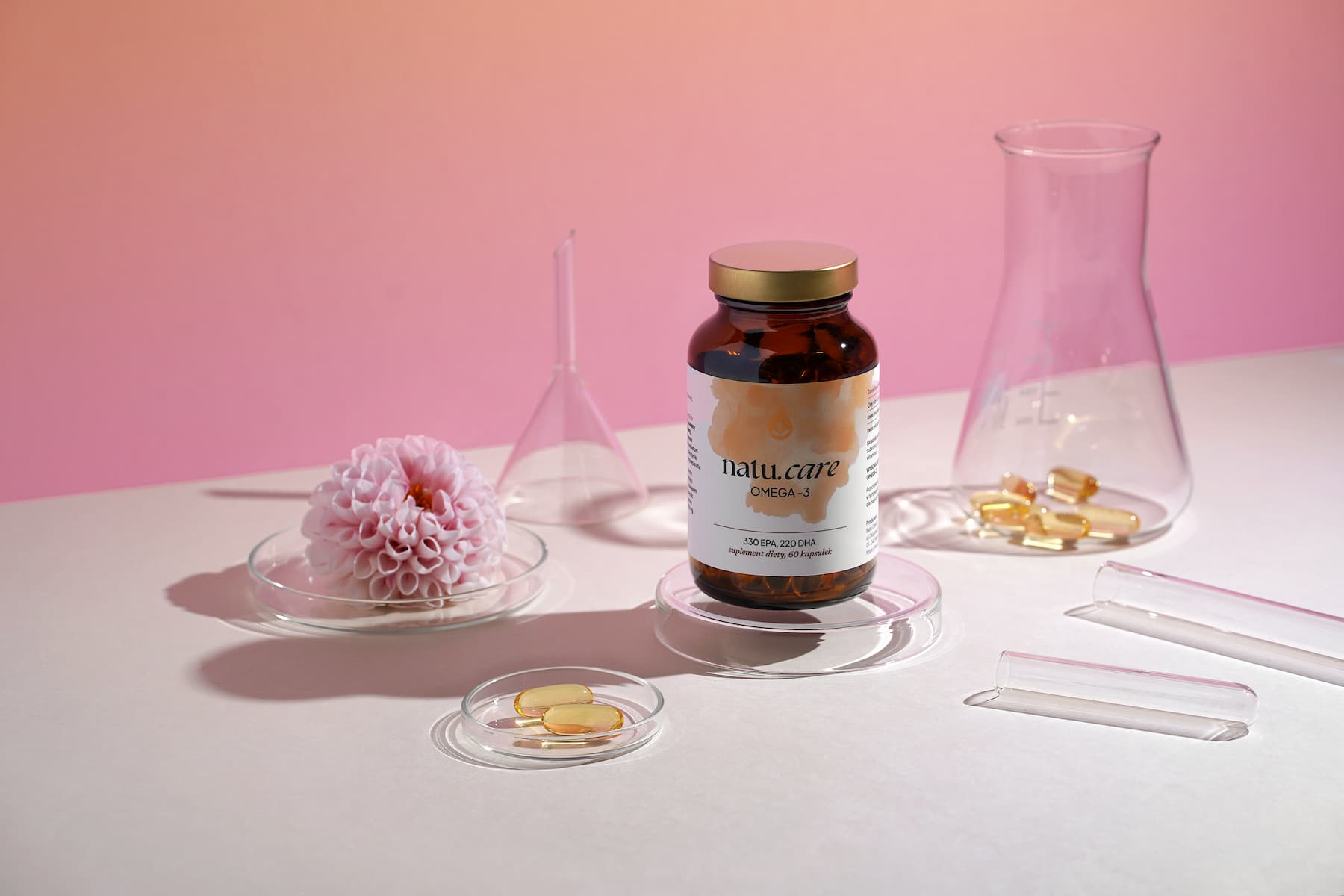
Omega-3 in a good dose and an optimum ratio of DHA and EPA acids will replenish valuable fats in the diet.
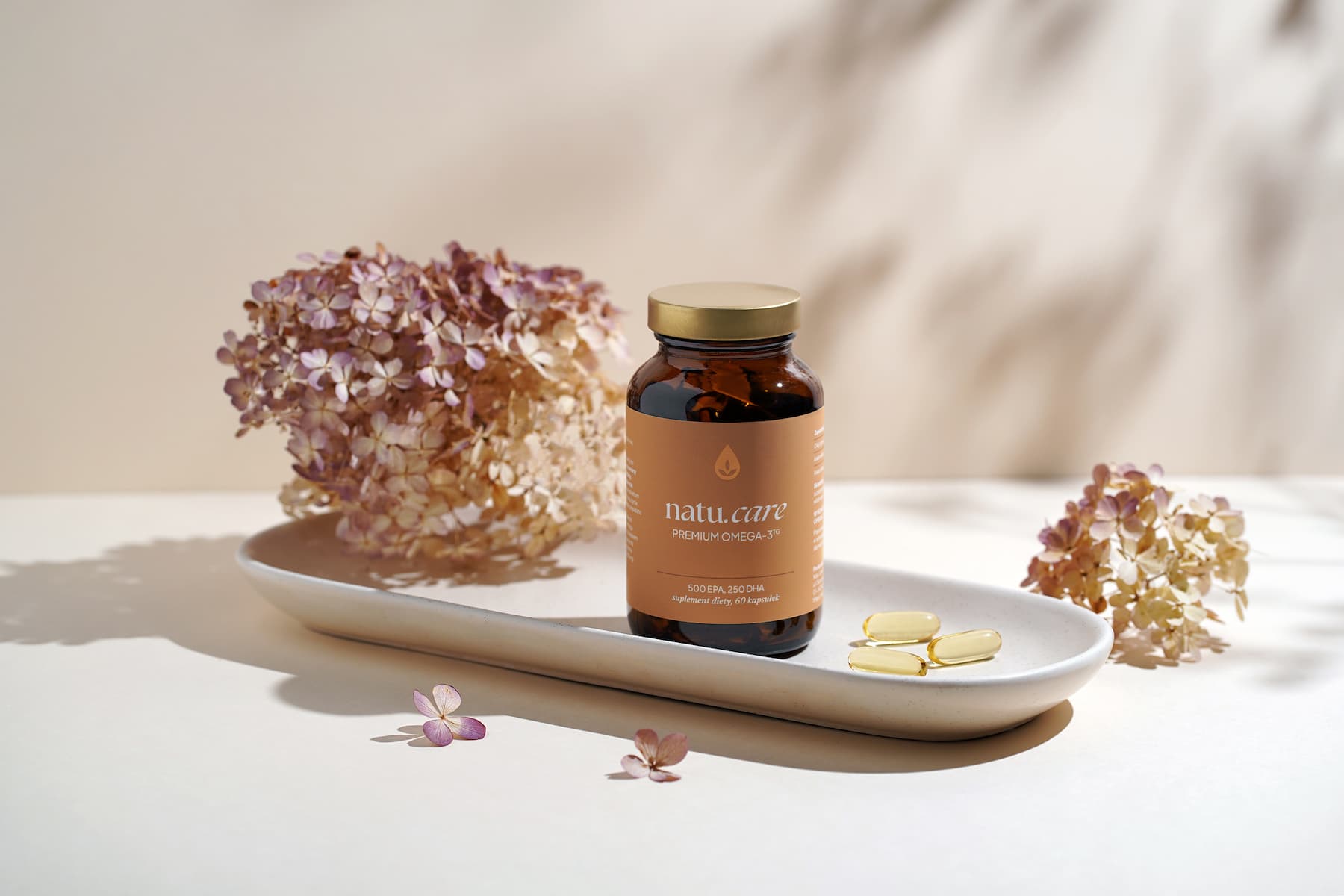
The omega-3 acids from Natu.Care are distinguished by their triglyceride form, which is characterised by high bioavailability.
